I TAKE A CLOSER LOOK, AND LIKE WHAT I SEE
/0 Comments/in Design, Gardening/by Lee Reich
Hey Bud, ‘Sup?
Nothing like winter to force me to take a closer look at my trees and shrubs. “To see what, you may ask?” To look at their buds, within which lie the makings of this season’s flowers and shoots. Not only are the buds quite distinctive, but they also offer a crystal ball into the future, which is very important to me as a fruit grower.
Trees’ and shrubs’ fruit and shoot buds look different from each other. It’s the fatter ones that open to become flowers and then, barring damage from late frosts, insects, diseases, or hail, fruits.
Last year, perhaps because of dry weather or a late spring freeze, my pawpaw crop was a failure. This explains why I now see so many distinctive plush, velvety, fat, brown buds — flower buds — lining the stems. For any fruiting plant, a light crop of fruit one year generally makes for a bumper crop the following year.

Pawpaw buds
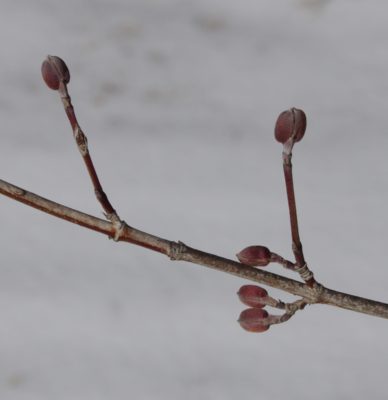
Cornelian cherry buds
My cornelian cherry tree also prognosticates a bumper crop, even more obviously, because its flower buds stand prominently proud of the stems like buttons on the ends of short stalks.
On peach trees, flower buds develop only on one-year-old stems. The flower buds aren’t that distinctive except for being fat. The buds at some nodes, the junction where leaves met stems last summer, come in triplets, one single, small shoot bud wedged practically into hiding between two big, fat flower buds. The buds tell of a good crop of, at least, flowers.
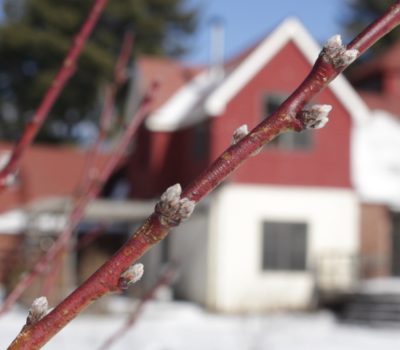
Peach buds
Apple buds are different still. Their flower buds are mostly on spurs, which are short, stubby growths that elongate only a half and inch or so each season. Not all buds on these spurs will open to flowers, though. Some — again, those that are less fat — will open to shoots that will grow only a fraction of an inch longer and then flower the following year.
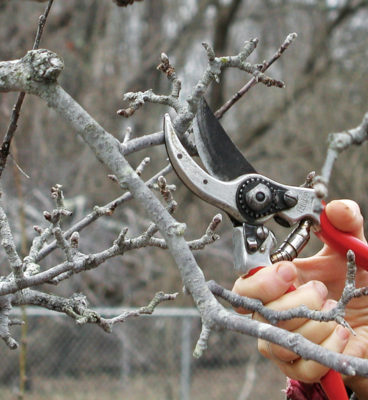
Apple buds
Pear buds are very similar to apple buds, the main difference being that I find it harder to differentiate, especially now, between their shoot from flower buds. As spring inches closer, these and other buds will all begin to swell to let their plans be better known.
A Bud Is Like A Crystal Ball
All this staring at buds is not just for winter entertainment. It also guides me in pruning.
To ripen a fruit demands a lot of a plant’s energy. If a tree or shrub bears too many fruits, it will, once danger from frosts and many other hazards are behind it, naturally shed some of the excess. But what’s left might still be more than it could ripen to perfect size and flavor for us humans.
One reason I’m stomping around among my trees and shrubs outside is to prune them, and one of many reasons that I prune them is to remove some of the fruits before they even begin to form. Cutting back some stems cuts off some flower buds, which makes for less fruits.
With all their fat flower buds, my pawpaw trees will get a severe pruning. The same for my peach tree, but not quite so severe. I’ll wait on the apples and pears until it becomes more evident what’s what.
Not that my sole purpose in pruning is to cut back fruit production. Some kinds of pruning cuts also are meant to stimulate vigorous shoot growth to reinvigorate a plant or provide flower buds for the following year. I’ll also prune to let branches bathe in light and air, keeping photosynthesis chugging along this summer and limiting pest problems. My cuts will also be directed towards maintaining strong limbs able to support a good crop. (Interested in more about pruning? See my book, THE PRUNING BOOK.)
Nice Bark, Woof, Woof
Looking at buds isn’t the only winter entertainment provided by my plants. How about checking out their bark?
Among the trees and shrubs I’ve planted, my three favorites barks are those of hackberry, river birch, and stewartia. Hackberry has a gray bark with ridges on it that, when struck by low winter sun, have a distinct, achromatic light and shadows that remind me of photos of the lunar landscape. My tree still have some years to grow before their bark is notable; for now, I enjoy looking at he bark on some wild plants I know.
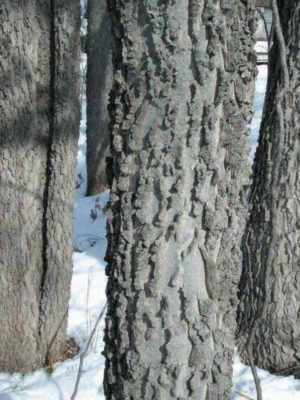
Hackberry bark
River birch bark has a cinnamon-colored bark that naturally curls and peels off up and down the trunk to create a colorful mix of creamy white, pink, and brown colors.
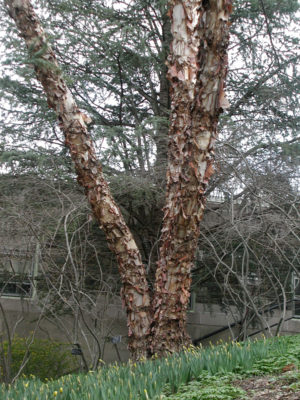
River birch
My Japanese stewartia has the bark that would stop traffic, if there was traffic here. This bark is mottled with dark brown, light brown, and silvery patches. In a few months, leaves will mostly hide the bark, but then white blossoms that look much like camellias will continue the show.
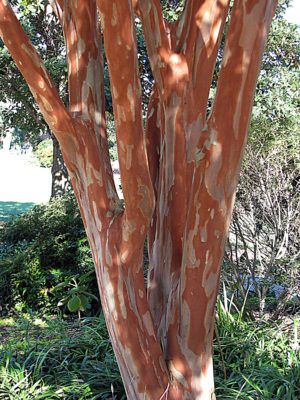
Stewartia bark
LECTURES IN THE PACIFIC NORTHWEST!
/2 Comments/in Gardening/by Lee ReichPlease join me for the following presentations later this month in and near Seattle: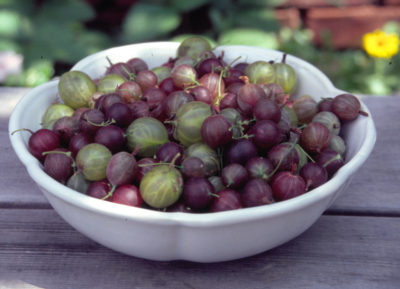
February 23, 2017
21 Acres Center for Local Food & Sustainable Living
13701 NE 171st St., Woodinville, WA
“Uncommon Fruits for Backyard and Small Farm”
February 24-25, 2017
Northwest Flower & Garden Show
Seattle, WA
“Luscious Landscaping with Fruiting Trees, Shrubs, and Vines”
“Fruits for Small Gardens”
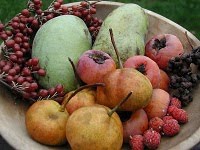
STEPPING INTO SPRING
/2 Comments/in Gardening, Pests, Vegetables/by Lee ReichCleanup Time Re-Starts in Veggie Garden
Warmer weather, even if it’s not all that warm, makes me feel like spring is just around the corner. The ground — in my vegetable beds, at least — isn’t even frozen, no doubt because water doesn’t linger long in the well-drained soil and because the dark-colored compost blanket I laid down in autumn sucks up the sun’s warmth.
So yesterday seemed like a perfect time to continue the garden cleanup that screeched to a halt when frigid weather struck, and some snow fell, a couple of months ago. Old cabbage heads that never quite ripened were laying on the ground like ratty, pale green tennis balls (with stalks attached). The four-foot-high stalk of one Brussels sprouts plant, stripped in autumn of its sprouts, stood sentry like a decrepit soldier in the same bed.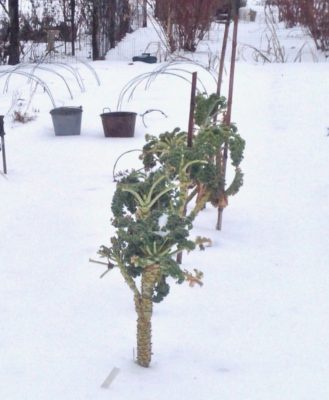
Of course, kale also still stood, except for those that flopped to the ground under their own weight. The latter were mostly the variety Tuscan (Lanciata). The Dwarf Blue Scotch plants, which I think taste better, stood more upright and compact, helped along, I’ll admit, with some bamboo stakes pushed into the ground next to them back in summer. I dug up the Tuscan kale plants and stripped yellowed and flaccid leaves from the Dwarf Blue Scotch plants. My guess is that by April they’ll be unfolding new, tasty leaves.
Stepping over to another bed, I twisted or coaxed out, with the help of my Hori-Hori knife, stumps from harvested lettuce and Chinese cabbage. A row of arugula in that bed showed enough life to awaken in spring with fresh, new leaves. I left it.
All this cleanup gets a jump on spring and removes debris that might harbor insect or disease pests that could infest or infect this season’s plants. The debris went into my garden cart and thence to the compost pile. The winter pile doesn’t heat up, so I’ll give the bacteria, fungi, actinomycetes, and earthworms two years to get their jobs done, killing off any “bad guys.”
Cursed Voles!
Stepping over to the remains of the endive bed that I planted towards the end of last summer and began harvesting in October — what havoc has been wreaked!
The bed had been covered with a tunnel of clear plastic and row cover to provide extra warmth to the plants in cold weather. Extra warmth also to some furry creatures, it seems.
Taking off the cover, I saw a bed riddled with tunnels along with the scattered remains of unharvested endive plants. This has happened in the past; something about endive seems particularly attractive to the furry creatures (and to me), which I assume are voles, which are mouse-like creatures.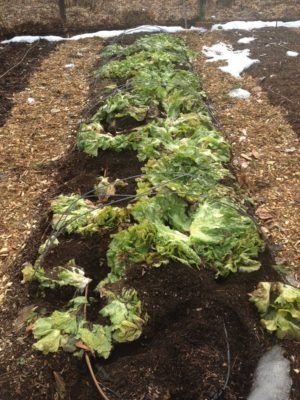
My garden must be vole heaven. The cat rarely hops the garden fence to hunt because she has to cross the DMZ zone to get to the garden, and she’s scared of our dog, Sammy. The compost-enriched soil has plenty of earthworm for good eating, as well as all the tasty, organic produce. So far, though, the voles have been satisfied with just the endive.
Short of planting the cat in the garden, which Sammy can’t enter, my plan is to do extensive trapping. One web site recommendation for a small garden is for twelve traps baited with oatmeal and peanut butter, or with apple.
As consolation, vole populations are said to decline after 3 to 5 years. It’s almost time, although the declined population might still be too many for me. And all is not bad with voles; they help stir the soil to distribute nutrients.
Pre-Season Warmup
While in the garden, I also did some pre-season weeding. Creeping Charlie, which enjoys cool weather, is always sneaking in here and there once I turn my attention away from the garden.
All this garden cleaning and straightening up isn’t all for practicality. It makes the view of the garden each morning from my second floor bedroom window prettier.

